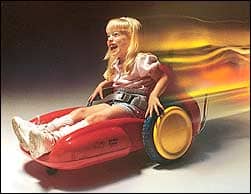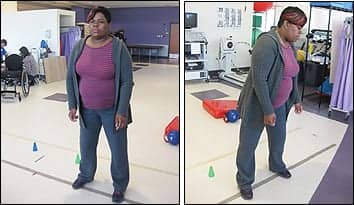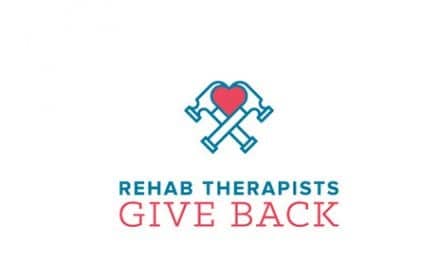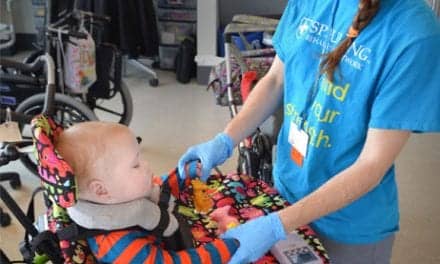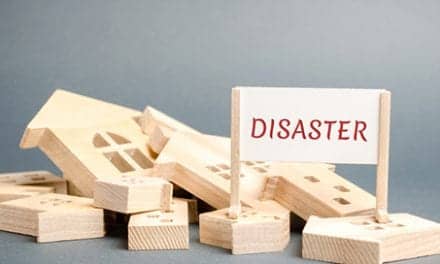Ever wish you had a seating and positioning fairy godmother? This month, I will grab my wand (it looks a bit like a lemon drop martini), and go to work. In this article, I will take your turmoil and turn it into usable solutions. I will send out the case to colleagues, and collect solutions. Together, we can learn about new equipment options and maybe even have some fun creating new solutions.
Addressing spina bifida
Latin for split spine, spina bifida is a developmental birth defect in which there is incomplete closure of the embryonic neural tube. This results in an incompletely formed spinal cord. In addition, the vertebrae overlying the open portion of the spinal cord do not fully form and remain unfused and open. This allows the abnormal portion of the spinal cord to protrude through the opening in the bones. There may or may not be a fluid-filled sac surrounding the open spinal cord.
Spina bifida malformations fall into three categories: spina bifida occulta, spina bifida cystica (myelomeningocele), and meningocele. Myelomeningocele is the most significant form and leads to disability in most affected individuals. The terms spina bifida and myelomeningocele are usually used interchangeably.
Spina bifida can be surgically closed after birth, but this does not restore normal function to the affected part of the spinal cord, and an individual with this condition will have dysfunction of the spinal cord and associated nerves from the point of the open defect and below. They may also have language, cognitive, and behavioral deficits.
Although intrauterine surgery for spina bifida has been successfully performed in the past, most physicians do not believe the risks of the surgery outweigh the benefits. The safety and efficacy of the procedure are currently under investigation.1
CLAUDE: A CASE STUDY
Claude is an 18-month-old boy diagnosed with T-12 myelomeningocele or spina bifida. Due to dislocated hips, he is 24 inches tall with a seat depth of 5 inches, and needs the footrests 6 inches from the top of the seat, and a seat back that can accommodate his prominent kyphosis. Claude’s cognition and upper extremity function are near normal.
His physical therapist would like to see Claude have some independent mobility, and provided him with a small car that he sits in and can propel using the wheels.
Now, the therapist would like to introduce power mobility, but the family lives in a second-story apartment without an elevator—a situation that is not likely to change. The challenge today is to recommend seating and mobility products for him.
 |
| A youngster demonstrates a mobility aid for pre-wheelchair users that looks like a car but handles like a wheelchair. Photo courtesy of Sammons Preston |
However, there are orthopedic issues to consider. Claude’s therapist is worried about accommodating his kyphosis. Sandy Cormier, CRTS, president of Rehab-in-Motion, San Antonio, has never personally seen the child, but when apprised of the case, she surmised that Claude’s kyphosis is really a gibbus deformity or “hump” from the spina bifida and not a true kyphosis. Therefore, it is not flexible or correctable, and needs to be supported and accommodated. Cormier recommends using thick foam, cutting out a beveled hole to accommodate the deformity, as well as rimming the edge with memory foam so the child can still move and not have pressure on this area.
Unfortunately, as Claude ages, he is likely to experience an increase in scoliosis and other spinal deformities (most likely lordosis), and subluxed or dislocated hips that will require reconstructive hip surgery. (Subluxed hips means that the femoral head is not sitting inside the socket all the way, and the ball is partly uncovered, whereas dislocation means the femoral head is totally uncovered.) Orthopedic surgeons can alter the angle and rotation of the femoral head and use bone chips from the patient or a cadaver to build up the rim of the socket. The femur is cut and then put back together using pins and/or plates that may or may not be permanent. Recovery time is usually 8 to 12 weeks, with a recent article suggesting that children do not return to presurgery functional levels until 12 months post surgery.
Most likely, Claude will always have tight or contracted hamstrings, no sensation below his lesion, and impaired weight-shifting abilities. In addition, he will need an aggressive seating system with a contoured cushion.
 |
| Sandy Cormier |
PLAN A—CORMIER’S RECOMMENDATIONS
Cormier recommends using the pediatric seating systems from a Simi Valley, Calif-based company.
“If you use their next-to-smallest system, you can get very low floor to seat height. Order the front-wheel-drive configurations so you can easily convert the system to rear wheel drive once Claude gets larger and stronger,” she says. “I would not do smallest frame but rather the 10- to 14-inch frame. This way, the chair can be grown as he gets larger.”
With the grid back that comes with this chair, the therapist can change the accommodation of the spine deformity as Claude grows, and Cormier’s recommended cutout for his kyphosis is in a different area.
Cormier says, “I really like to use grids that are layered T-foams, with at least 1.5 inches as the top layer. You can cut the necessary grids to the depth you need to accommodate Claude’s kyphosis/gibbus.
 |
| A pediatric wheelchair with front wheel drive offers growth capability and low floor to seat height. Photo courtesy of Freedom Designs. |
“When the patient changes, the rehab specialist only needs to order a new grid fit kit to customize the back as needed,” she says. “If you have a 3- or 4-inch-thick back to accommodate the kyphosis, you would just use the hardware to place the back 1 inch in front of the push canes to get the 5-inch seat depth.”
Cormier says that she would cut the back so it could fit between the push canes for the following reasons: that it provides support but does not interfere with lateral/posterior use of the upper extremity, and that moving the back between the push canes as the child grows is an easy and inexpensive adjustment.
“I find it very difficult to fit or switch manual wheelchair seating systems to power wheelchairs,” says Cormier. “Generally, the tubing on each is different and moving the seating is not easy, but I do not know the client, family, and school support. Also, the power chair that I most often use on kids this age is made in Sweden and [available from a company] located in Tennessee. The model I like comes with a seat elevator that is included in the base price, has a very small footprint, and is generally easy to fund.”
PLAN B—MY TWO CENTS’ WORTH
For young children, I am having a lot of success with an early intervention series from Ireland that is distributed in the United States and Canada through a catalog from a Bolingbrook, Ill, company (and in Europe by a Duderstadt, Germany-based company). The unit goes so small that I can easily seat my infants in it. Also, it fits into a stroller (dependent mobility) and a high/low base, and easily comes apart. The seat adjusts without the use of tools—which is great—as Claude is likely to grow quickly. When he needs it, this same seat can fit into a high/low base, a manual wheelchair, or a power base. The problem will be finding out which are compatible and are actually easy to use. (That decision I will leave to my supplier, or I’ll call Sandy Cormier.) I tend to use the power system at school—where it is left—or in a neighbor’s garage before and after the school bus comes.
 |
 |
| The pediatric power base (above, left) can be accessorized with equipment to suit the child’s individual drive requirements. The author recommends a pediatric power-operated stander (above, right) to train her young clients to self-propel. Photos courtesy of Ginny Paleg. | |
For Claude, I agree with Cormier’s choice of a reverse configuration so he could reach the wheels. There is some evidence that if he starts manual propelling early enough, his shoulders will form according to the stress put on them and he will not have trouble with carpal tunnel syndrome down the line. (To learn more about this theory, contact Kendra Betz, PT, manager of the comprehensive Outpatient Physical Therapy Service and the Physical Therapy Clinical Education Program for the SCI Service at the VA Puget Sound Health Care System, Seattle.) Also, I will try to line up the center of the wheel with the middle finger, as his arms hang down at his side. I usually use the one from a Colorado-based company. As for power mobility, Claude is probably going to be a joystick driver, so any of the pediatric power bases will work. I would start introducing power now, or as early as possible. I prefer to use the power stander for training, but any power chair that is lying around can be used—stick a small positioning insert in and go.
I have also used the small low-end seats made for dining room chairs that cost under $100. They are available from a Germany-based company that has offices in Minneapolis.
 |
 |
| A small positioning insert (above, left – photo courtesy of Ginny Paleg) or a low-end seat (above, right – photo courtesy of Otto Bock)(originally made for a dining chair) can be used when a child starts to self-propel to help alleviate stress in shoulder development that might eventually result in carpal tunnel syndrome. | |
FURTHER TRAINING RECOMMENDATIONS
Claude should train for 15 to 20 minutes three to five times a week. He also needs to be in a stander for maintenance of bone density and stretching of his hip flexors and (maybe) hamstrings. I would recommend a model that he can self-propel. This way he is strengthening his upper extremities and learning to explore his environment while standing.
 |
| Mobile standing frames, promote bone density, upper extremity strength, and hamstring flexibility. Available in sizes for children age 1 to 18 years, with a wide variety of accessories (Snug Seat is pictured). |
Also, existing literature should be checked to determine his potential for ambulation. One article suggests that if we can get Claude to walk at all, even for a year or two, it will improve his ability to transfer and catheterize himself when he is an adult. At T-12, my best evidence-based guess is that he would have only a 10% chance of becoming a limited household ambulator. With the addition of dislocated hips and a kyphosis/gibbus, this assumption might be a stretch. A therapist could try treadmill training combined with electrical stimulation, and the use of a reciprocating gait orthosis and walker—then, try their best for results. In addition, a therapist would need medical clearance to employ these therapies. Unfortunately, the existing hip and spine issues will, most likely, make this impossible.
IN CONCLUSION
My latest approach is to get the child a seating system by age 1, then a power chair at 4 years of age (or as soon as funding can be secured). Families need positioning systems for feeding and play, and those with indoor bases and stroller bases can usually be funded. Two years later, we can usually get funds for power. In the interim, we might be able to convert the seating system to manual mobility. (I am firmly convinced that power builds cognition, language, and personality, and wish that all babies had some form of augmentative mobility by age 1, no matter what their diagnoses.)
If the child’s family housing situation is inconvenient for a power base, the unit could be housed at school, in a lobby, or in a neighbor’s garage until accessible housing is found. Affected families should put in their applications now, and contact the US Department of Housing and Urban Development (www.hud.gov) to get an advocate to help hasten the process.
I hope this article has been helpful. If you have any questions, ideas, or challenges—or want to become “an expert” at problem solving, contact me at .
Ginny S. Paleg, MS, PT, is an NDT-certified pediatric physical therapist and a University of Maryland doctoral candidate, Silver Spring, Md. She is the APTA representative for pediatric section reimbursement, a Listserv monitor, and CEU instructor. Paleg also serves on the editorial advisory board of Rehab Management. She can be reached at .
Reference
- Spina bifida, Wikipedia. [removed]en.wikipedia.org/wiki/Spina_bifida[/removed].

For more pediatric seating solutions from physical therapist Ginny S. Paleg, search our free online archives.

